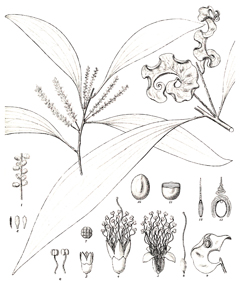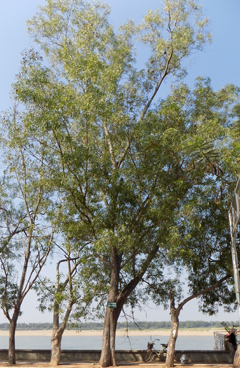 |
|
http://www.edibleplants.org/ |
 |
| wikimedia.org User:Pamputt |
Translate this page:
Summary
A useful agroforestry plant with minor edible uses. It can grow to 20m and has a dense round crown. A crooked, gnarly tree good for shade. A rough hard bark grayish green in colour on a 50cm diameter trunk. Sickle shaped shiny dark green leaves 10-20cm long taper to a blunt tip and are 1.5 – 3.5 cm wide. Three main veins are prominent. Flowers are dull golden/yellow rods occurring in pairs. Early spring, Late spring, Mid spring. Acacia auriculiformis has distinctive ear-like pods, woody twisted and hard. Roots are shallow and spreading. There are about 1,350 Acacia species with over 1,000 occuring in Australia. Acacia auriculiformis can become invasive in the wrong conditions. Nitrogen fixing: Acacia auriculiformis can fix nitrogen after nodulating with a range of Rhizobium and Bradyrhizobium strains. It also has associations with both ecto- and endo-mycorrhizal fungi.
Physical Characteristics

 Acacia_auriculiformis is an evergreen Tree growing to 25 m (82ft) by 5 m (16ft) at a fast rate.
Acacia_auriculiformis is an evergreen Tree growing to 25 m (82ft) by 5 m (16ft) at a fast rate.
See above for USDA hardiness. It is hardy to UK zone 10 and is frost tender. The flowers are pollinated by Insects.
It can fix Nitrogen.
It is noted for attracting wildlife.
Suitable for: light (sandy), medium (loamy) and heavy (clay) soils, prefers well-drained soil and can grow in nutritionally poor soil. Suitable pH: mildly acid and neutral soils and can grow in very acid and saline soils.
It cannot grow in the shade. It prefers dry or moist soil and can tolerate drought. The plant is not wind tolerant.
UK Hardiness Map
US Hardiness Map
Synonyms
Racosperma auriculiforme (Benth.) Pedley; Acacia auriculaeformis; Acacia moniliformis Griseb.
Plant Habitats
Edible Uses
Gum, Seeds - oil. The gum is eaten in Australia.
References More on Edible Uses
Medicinal Uses
Plants For A Future can not take any responsibility for any adverse effects from the use of plants. Always seek advice from a professional before using a plant medicinally.
None known
References More on Medicinal Uses
The Bookshop: Edible Plant Books
Our Latest books on Perennial Plants For Food Forests and Permaculture Gardens in paperback or digital formats.

Edible Tropical Plants
Food Forest Plants for Hotter Conditions: 250+ Plants For Tropical Food Forests & Permaculture Gardens.
More

Edible Temperate Plants
Plants for Your Food Forest: 500 Plants for Temperate Food Forests & Permaculture Gardens.
More

More Books
PFAF have eight books available in paperback and digital formats. Browse the shop for more information.
Shop Now
Other Uses
Attractive flowers or blooms. Agroforestry Uses: In its native habitat, the tree is a colonizer of tropical coastal lowlands. It has the potential to be a pioneer species, but its tendency to spread into the local environment reduces its value as a pioneer outside of its native range[ 320 , K ]. The plant has a spreading, superficial and densely matted root system, which makes it suitable for stabilizing eroded land[ 303 ]. Its rapid early growth, even on infertile sites, ability to fix atmospheric nitrogen and tolerance of both highly acidic and alkaline soils make it popular for stabilizing and revegetating mine spoils[ 303 ]. Plantations of the tree improve soil physio-chemical properties such as water-holding capacity, organic carbon, nitrogen and potassium through litter fall. Its phyllodes provide a good, long-lasting mulch[ 303 ]. The dense, dark-green foliage, which remains throughout the dry season, makes it an excellent shade tree[ 303 ]. Other Uses The bark contains sufficient tannin (13 - 25%) for commercial exploitation[ 303 ] A natural dye, used in the batik textile industry in Indonesia, is also extracted from the bark[ 303 ]. The heartwood is light brown to dark red; it is demarcated from the yellow sapwood. The wood is hard, has a high basic density; is fine and straight-grained; often attractively figured; reasonably durable and finishes well[ 303 , 404 ]. It is excellent for turnery articles, toys, carom coins, chessmen and handicrafts[ 303 ]. Also used for furniture, joinery, tool handles, and for construction if trees of suitable girth are available[ 303 ]. The wood is extensively used for paper pulp. Plantation-grown trees have been found promising for the production of unbleached kraft pulp and high-quality, neutral, sulphite semi-chemical pulp[ 303 ]. A major source of firewood, its dense wood and high energy (calorific value of 4500-4900 kcal/kg) contribute to its popularity. It provides very good charcoal that glows well with little smoke and does not spark[ 303 ].
Special Uses
References More on Other Uses
Cultivation details
The tree is predominantly found at low elevations in the seasonally dry tropical lowlands of the humid and sub-humid zones[ 303 ]. It is usually found at elevations below 80 metres, but can be found up to 400 metres[ 303 ]. In its natural range, the mean annual rainfall varies from 700 - 2,000 mm, and the dry season (i.e. Monthly rainfall less than 40 mm) can be up to 7 months[ 303 ]. The mean maximum temperature of the hottest month is 32 - 34°c, and the mean minimum of the coolest month is 17 - 22°c[ 303 ]. Frost does not occur in its natural range, but elsewhere, it tolerates light frost[ 303 ]. Requires a sunny position, it is very intolerant of shade[ 303 , 404 ]. Found most commonly on clay soils, it exhibits the ability to grow in a wide variety of soils including calcareous sands and black cracking clays, seasonally waterlogged soils, sandy loams and coral rag[ 303 ]. It can also tolerate highly alkaline and saline soils, pH ranging between 4.3 and 9[ 303 , 404 ]. It has brittle, easily-broken branches and therefore requires a position sheltered from strong winds[ 303 ]. Established plants can tolerate periodic inundation and are also very drought tolerant[ 309 ]. Often cultivated for timber outside its native range, the tree has escaped from cultivation in many parts of the tropics and has become an invasive weed in some areas[ 303 , 305 ]. Very fast-growing, an increment in height of 2 - 4 metres per year in the first few years is common even on soils of low fertility[ 303 ]. The optimal planting density is not clearly established. Most current plantings are spaced at 2 - 4 x 2 - 4 metres, the closer spacing being more suitable for firewood and pulp plantations[ 303 ]. The tree responds well to pollarding[ 303 ]. Young trees respond to coppicing better than old trees, but the tree does not sprout vigorously or prolifically. Best results are obtained if the stump is cut at a height of 0.6 - 1 metre above the ground[ 303 ]. Under favourable conditions, trees may reach a height of 15 metres in 5 years and produce an annual wood increment of 15-20 cubic m/ha over 10 - 12 years[ 303 ]. Recommended rotation is 4 - 5 years for fuel wood, 8 - 10 years for pulp and 12 - 15 years for timber[ 303 ]. Removal of lower branches and of young plants has been suggested as a means of improving stem form and of reducing the incidence of multiple stems[ 303 ]. The tree has a shallow, spreading root system[ 303 ]. Seedlings have the ability to compete with Imperata cylindrica during early growth phases and once mature may reduce the grass to a sparse ground cover[ 303 ]. Hybridizes with A. Mangium[ 320 ]. The plant flowers and produces fruit throughout much of the year[ 451 ]. This species has a symbiotic relationship with certain soil bacteria, these bacteria form nodules on the roots and fix atmospheric nitrogen. Some of this nitrogen is utilized by the growing plant but some can also be used by other plants growing nearby[ 200 ].
References Carbon Farming Information and Carbon Sequestration Information
Temperature Converter
Type a value in the Celsius field to convert the value to Fahrenheit:
Fahrenheit:
The PFAF Bookshop
Plants For A Future have a number of books available in paperback and digital form. Book titles include Edible Plants, Edible Perennials, Edible Trees,Edible Shrubs, Woodland Gardening, and Temperate Food Forest Plants. Our new book is Food Forest Plants For Hotter Conditions (Tropical and Sub-Tropical).
Shop Now
Plant Propagation
Seed - requires pre-treatment to break down the hard coat[ 303 ]. Pouring a small amount of boiling water over the seeds (which cools down quickly and so does not cook the seed), and then leaving to soak for 12 hours is usually effective, as is making a small incision in the coat to allow water to penetrate. Germination levels of 40 - 80% take place in 6 - 15 days[ 303 ]. Treated seeds are sown in germination beds, and seedlings are transplanted into polythene bags when they reach the 2-leaf-pair stage. Seeds can also be sown straight into polythene bags. Young seedlings should initially be kept at 50% sunlight, but this can be increased to 70% once they have been established. In general, 3 - 4 months are needed to raise seedlings to a plantable size, 25 cm in height[ 303 ]. Seeds stored in airtight containers at room temperature retain their viability for several years[ 303 ]. Cuttings. Air layering.
Other Names
If available other names are mentioned here
Also known as: Akasia kuning, Bunga siam, Earleaf wattle, Kasia, Kathin-narong, Keo bong vang, Kratin-narong, Northern Black wattle, Pohon akasia, and Unar.
Native Range
TROPICAL ASIA: Indonesia, Papua, Papua New Guinea, AUSTRALASIA: Australia, Queensland (north), Northern Territory (north),
Weed Potential
Right plant wrong place. We are currently updating this section.
Please note that a plant may be invasive in one area but may not in your area so it's worth checking.
This plant can be weedy or invasive: Florida Exotic Pest Plant Council. Florida. [1c] Bahamas, Bangladesh, Singapore,Hawaii, USA. [1d]
Conservation Status
IUCN Red List of Threatened Plants Status : Least Concern.

Growth: S = slow M = medium F = fast. Soil: L = light (sandy) M = medium H = heavy (clay). pH: A = acid N = neutral B = basic (alkaline). Shade: F = full shade S = semi-shade N = no shade. Moisture: D = dry M = Moist We = wet Wa = water.
Now available:
Food Forest Plants for Mediterranean Conditions
350+ Perennial Plants For Mediterranean and Drier Food Forests and Permaculture Gardens.
[Paperback and eBook]
This is the third in Plants For A Future's series of plant guides for food forests tailored to
specific climate zones. Following volumes on temperate and tropical ecosystems, this book focuses
on species suited to Mediterranean conditions—regions with hot, dry summers and cool, wet winters,
often facing the added challenge of climate change.
Read More
Expert comment
Author
A.Cunn. ex Benth.
Botanical References
Links / References
For a list of references used on this page please go here
Readers comment
| Add a comment |
|
If you have important information about this plant that may help other users please add a comment or link below. Only comments or links that are felt to be directly relevant to a plant will be included. If you think a comment/link or information contained on this page is inaccurate or misleading we would welcome your feedback at [email protected]. If you have questions about a plant please use the Forum on this website as we do not have the resources to answer questions ourselves.
* Please note: the comments by website users are not necessarily those held by PFAF and may give misleading or inaccurate information.
To leave a comment please Register or login here All comments need to be approved so will not appear immediately.
|
Subject : Acacia_auriculiformis
|
|
|
|